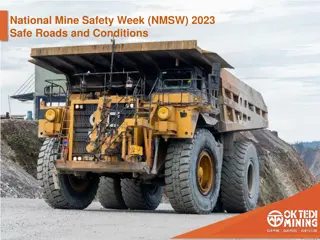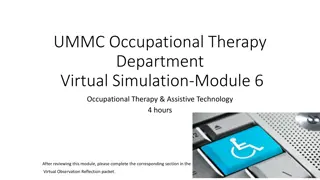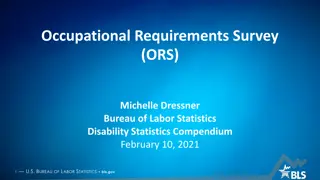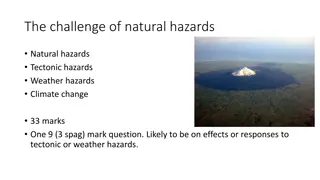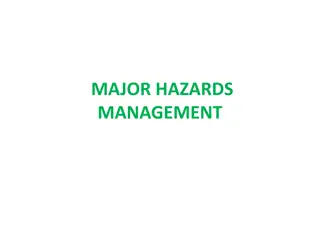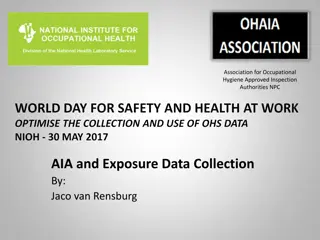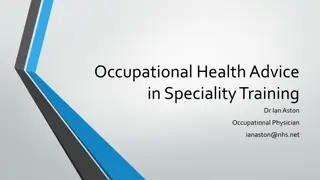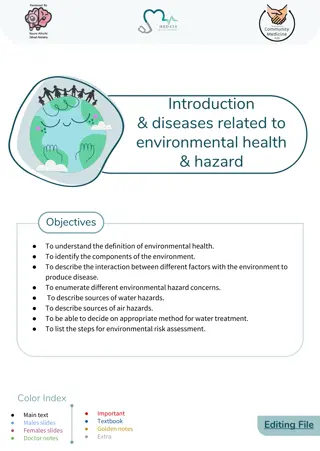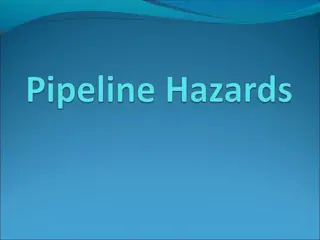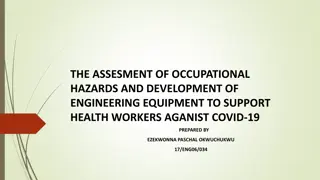
Occupational Diseases: Understanding Major Risks and Timeframes
Explore the concept of occupational diseases caused by workplace exposures such as physical hazards, chemical agents, and biological agents. Learn about the varying timeframes in which these diseases may develop, from instantaneous reactions to long-term effects like lead poisoning and occupational carcinogens.
Download Presentation

Please find below an Image/Link to download the presentation.
The content on the website is provided AS IS for your information and personal use only. It may not be sold, licensed, or shared on other websites without obtaining consent from the author. If you encounter any issues during the download, it is possible that the publisher has removed the file from their server.
You are allowed to download the files provided on this website for personal or commercial use, subject to the condition that they are used lawfully. All files are the property of their respective owners.
The content on the website is provided AS IS for your information and personal use only. It may not be sold, licensed, or shared on other websites without obtaining consent from the author.
E N D
Presentation Transcript
Faculty of Medicine Family and Community Medicine Faculty of Medicine Diseases related to occupational hazards YEAR 1439-1440 Hajji 2018 - 2019Gregorian Objectives 1. understand major diseases related to occupational hazards 2. Physical hazards, heat, light, pressure, noise, radiation, electricity, mechanical factors, Chemical agents Gases, fumes, dust, metals and their compounds, solvents, Biological agents, Occupational cancers, Occupational dermatosis Introduction to Environmental & Occupation Health 1
Faculty of Medicine Family and Community Medicine Faculty of Medicine Occupational disease: The term "occupational disease" refers to those illnesses caused by exposures at the workplace. They should be separated, conceptually, from injuries that may also occur at workplaces due to a variety of hazards. Introduction to Environmental & Occupation Health 2
Faculty of Medicine Family and Community Medicine Faculty of Medicine Occupational diseases may occur in varying time frames, from the instantaneous development of illness following exposure to toxic chemicals to decades between onset of exposure and the development of disease, as occurs with many occupationally related cancers. Introduction to Environmental & Occupation Health 3
Faculty of Medicine Family and Community Medicine Examples of varying time frames include Faculty of Medicine instantaneous reactionsto exposure to chemicals such as chlorine or ammonia gas; a delay of some six to twelve hours with fumes of aerosolized zinc, as occurs when welding on galvanized steel; Introduction to Environmental & Occupation Health 4
Faculty of Medicine Family and Community Medicine Faculty of Medicine a delay of weeks to months with lead poisoning; a delay of decades with occupational carcinogens; the finding of congenital malformations in children whose parents may have been exposed to hazardous materials. Introduction to Environmental & Occupation Health 5
Faculty of Medicine Family and Community Medicine Faculty of Medicine Although not all occupational exposures that cause illness lead to death, considerable numbers of deaths each year are associated with workplace exposures. While it is relatively easy to count deaths due to occupational injuries, it is much more difficult for delayed illnesses. Introduction to Environmental & Occupation Health 6
Faculty of Medicine Family and Community Medicine Faculty of Medicine More than 6,200 fatal occupational injuries occur in the United States each year, with more than 40 percent associated with transportation, and most of these related to motor-vehicle fatalities. Introduction to Environmental & Occupation Health 7
Faculty of Medicine Family and Community Medicine Faculty of Medicine As noted above, deaths from occupational illness for most diseases are hard to enumerate. The only diseases for which reasonably good data exists are the pneumoconiosis, such as asbestosis, coal-workers pneumoconiosis, and silicosis. Introduction to Environmental & Occupation Health 8
Faculty of Medicine Family and Community Medicine Faculty of Medicine Introduction to Environmental & Occupation Health 4/3/2011 9
Faculty of Medicine Family and Community Medicine Faculty of Medicine Introduction to Environmental & Occupation Health 10
Faculty of Medicine Family and Community Medicine Faculty of Medicine Introduction to Environmental & Occupation Health 11
Faculty of Medicine Family and Community Medicine Faculty of Medicine For many other diseases, such as those from chemical exposure, various occupational cancers, and other problems, individual fatalities are difficult to recognize and record. Introduction to Environmental & Occupation Health 12
Faculty of Medicine Family and Community Medicine Faculty of Medicine Among the occupational diseases most commonly reported, those relating to repeated trauma, such as carpal tunnel syndrome, tendonitis, and noise induced hearing loss Introduction to Environmental & Occupation Health 13
Faculty of Medicine Family and Community Medicine Faculty of Medicine For those cases of carpal tunnel syndrome with workplace absence, half needed twenty-five or more days away from work. Introduction to Environmental & Occupation Health 14
Faculty of Medicine Family and Community Medicine Faculty of Medicine Skin diseases represented about 13 percent of work related illnesses. Occupational Dermatitis is often an inflammatory skin reaction caused by occupational contact factors. Dermatitis, or inflammation of the skin cases required time away from work. Introduction to Environmental & Occupation Health 15
Faculty of Medicine Family and Community Medicine Faculty of Medicine 1. Noise: Noise is most obviously a problem in industries such as manufacturing and construction, it can also be an issue in a wide range of other working environments Introduction to Environmental & Occupation Health 16
Faculty of Medicine Family and Community Medicine Faculty of Medicine One in five of Europe s workers have to raise their voices to be heard for at least half of the time that they are at work and 7% suffer from work-related hearing difficulties. Noise induced hearing loss is the most common reported occupational disease in the EU. Introduction to Environmental & Occupation Health 17
Faculty of Medicine Family and Community Medicine Faculty of Medicine What is noise? Noise is an unwanted sound; its intensity ( loudness )is measured in decibels (dB). The decibel scale is logarithmic, so a three-decibel increase in the sound level already represents a doubling of the noise intensity. Introduction to Environmental & Occupation Health 18
Faculty of Medicine Family and Community Medicine Faculty of Medicine For example, a normal conversation may be about 65 dB and someone shouting typically can be around 80dB. The difference is only 15 dB but the shouting is 30 times as intensive Introduction to Environmental & Occupation Health 19
Faculty of Medicine Family and Community Medicine Faculty of Medicine The duration of exposure is also very important. To take this into account, time-weighted average sound levels are used. For workplace noise, this is usually based on an 8-hour working day. Introduction to Environmental & Occupation Health 20
Faculty of Medicine Family and Community Medicine Faculty of Medicine PERMISSIBLE NOISE EXPOSURES Duration per day, hours 8 6 4 3 2 1 1/2 1 1/2 1/4 or less Sound level dBA slow response 90 92 95 97 100 102 105 110 115 Introduction to Environmental & Occupation Health 21
Faculty of Medicine Family and Community Medicine Faculty of Medicine What problems can noise cause? Increasing the risk of accidents by masking warning signals; Physiological effects Increase the risk of hearing loss; Being a causal factor in work- related stress. Introduction to Environmental & Occupation Health 22
Faculty of Medicine Family and Community Medicine Faculty of Medicine Who is at risk? Anyone who is exposed to noise is potentially at risk. The higher the noise level, and the longer you are exposed to it, the more risk you have of suffering harm from noise. Introduction to Environmental & Occupation Health 23
Faculty of Medicine Family and Community Medicine Faculty of Medicine Noise is being recognized as a problem in service sectors such as education and healthcare, bars and restaurants. A study of noise in kindergartens found some averaging noise levels over 85dB Introduction to Environmental & Occupation Health 24
Faculty of Medicine Family and Community Medicine Faculty of Medicine During a performance of Swan Lake, a conductor was recorded as being exposed to 88dB Introduction to Environmental & Occupation Health 25
Faculty of Medicine Family and Community Medicine Faculty of Medicine Truck drivers can be exposed to 89dB Noise on pig farms has been measured up to 115dB Introduction to Environmental & Occupation Health 26
Faculty of Medicine Family and Community Medicine Faculty of Medicine 2. Heat Stress Workers who are exposed to extreme heat or work in hotenvironments may be at risk of heat stress. Exposure to extreme heat can result in occupational illnesses and injuries. Introduction to Environmental & Occupation Health 27
Faculty of Medicine Family and Community Medicine Faculty of Medicine Heat stress can result in heat stroke, heat exhaustion, heat cramps, or heat rashes. Introduction to Environmental & Occupation Health 28
Faculty of Medicine Family and Community Medicine Faculty of Medicine Heat can also increase the risk of injuries in workers as it may result in sweaty palms, fogged-up safety glasses, dizziness. Burns may also occur as a result of accidental contact with hot surfaces or steam. Introduction to Environmental & Occupation Health 29
Faculty of Medicine Family and Community Medicine Faculty of Medicine Workers at risk of heat stress include outdoor workers and workers in hot environments such as firefighters, bakery workers, farmers, construction workers, miners, boiler room workers, factory workers, and others. Introduction to Environmental & Occupation Health 30
Faculty of Medicine Family and Community Medicine Faculty of Medicine References 1. Forbes BA, Sahm DF, Weissfeld AS. Bailey and Scott s Diagnostic Microbiology. 12th ed. US: Mosby Elsevier Science; 2007. 2. Central for Disease Control: www.cdc.gov 3. American Industrial Hygiene Association Journal. 4. Annals of Occupational Hygiene and Safety. 5. Journal of Analytical Chemistry. 6. NIOSI Pocket Guide to Chemical Hazards. 7. Journal of Air and Waste Management 8. http://jb.asm.org 9. http://jcm.asm.org 10. http://pathmicro.med.sc.edu/book/welcome.htm 11. www.foodhygienecd.net 12. www.foodhygiene.com 13. www.ourfood.com Introduction to Environmental & Occupation Health 31
Faculty of Medicine Family and Community Medicine Faculty of Medicine Introduction to Environmental & Occupation Health 32


